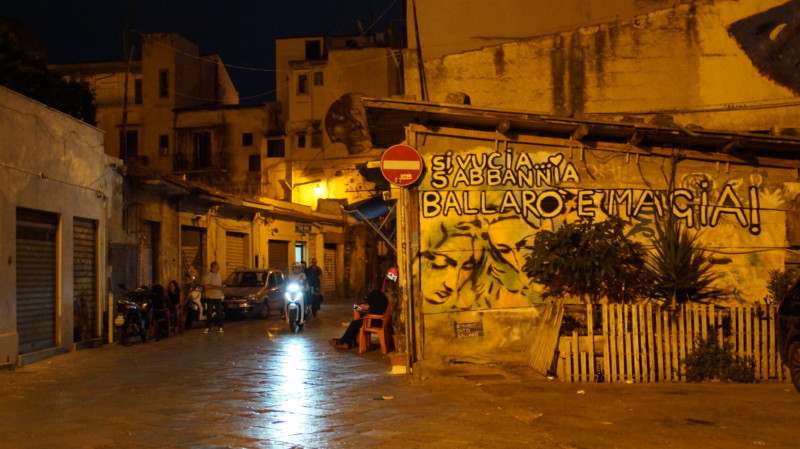
New York has given me that Refuge
In this film, refugee South Asian LGBTQ+ activist Barbara Khan talks about her migration from Pakistan and her life in New York as a trans woman.

The term Sanctuary City is of religious origin. It can be found in the writings of almost all world religions. The Bible speaks of six “sanctuary cities” who unintentionally killed a human being were safe from persecution:
“The LORD spoke to Moses: Speak to the Israelites and say to them: When you cross the Jordan into the land of Canaan, identify for yourselves cities to be refuge cities, where a person who kills someone by accident may flee. The cities will be for you a place of refuge from the close relative of the dead. The person who killed someone may not be put to death until he stands before the community for judgment. You will establish six refuge cities for yourselves. You will establish three cities across the Jordan and three cities in the land of Canaan. They will be the refuge cities. These six cities will be refuge for Israelites, immigrants, and temporary residents, as a place to flee for anyone who kills a person by accident.” (Quote from the Bible) 11Numeri 35: 9-15.
Even today the term often has religious connotations; the German Church Asylum can be understood within this tradition. Of religious origin comes the first usage of the term as well in modern times:
In 1971, some of the soldiers on the US aircraft carrier USS Coral Sea protested against the Vietnam War and refused to be recruited. In reaction, University Lutheran Chapel in Berkeley partnered with 17 other church congregations to offer soldiers protection from the potential penalties of refusing to obey orders. An offer was later joined by the city of Berkeley. That included the attempt to organize sleeping places, food, medical assistance, and support with legal issues. Additionally, there was the decision that municipal authorities did not cooperate with higher authorities in taking punitive measures against the refusing soldiers. This involved the municipal police as well. 22Ridgley, Jennifer, 2011: „Refuge, Refusal, and Acts of Holy Contagion: The City as a Sanctuary for Soldiers Resisting the Vietnam War“. 27., p.190-194.
This decision to refuse cooperation is today an essential component of US-American Sanctuary Cities. However, sanctuary city concepts also exist in other countries. Sheffield describes itself since 2007 as City of Sanctuary. Since then around 100 cities joined the movement in the UK. There are similar projects in Canada since the 1980s
In the European context, six cities in Italy in particular, most notably Palermo, are trying to find new, alternative solutions and ways to protect refugees at the local level, in opposition to Italian nation-state policies, as well as working together in a coalition of cities to be more assertive.
Despite their similar names, the various concepts differ greatly in terms of their competences and activities and are not directly comparable with each other. They are therefore presented separately below.

Right now, 11 states and 180 cities and municipalities are organized as Sanctuary Cities in the US. That doesn’t mean that something like a common charter which shapes the actions exists. However, the participating states, cities and municipalities have laws or are commiting to protect illegal migrants from persecution, especially by the United States Immigration and Customs Enforcement (ICE). The most common policy is the “Don’t Ask Don’t Tell” (DADT) policy. In cities such as San Francisco or New York, cards are given out for identification purposes, which are valid as identification documents regardless of whether the resident is in possession of other official documents. In some municipalities, mostly near the border, documents issued by the Mexican authorities to Mexicans living abroad are also accepted.
Sanctuary Cities offer illegalised migrants a certain protection against Persecution or imminent deportation. These measurements can’t be seen as an absolute protection, nation-state-agencies such as the ICE can still act within these cities and transpose national law. The underlying problem of illegalisation of human beings isn’t solved. 33This was evident during Donald Trump’s administration, when hundreds of illegal migrants were arrested during raids targeted at sanctuary cities. Source: LA Times: https://www.latimes.com/local/lanow/la-me-ice-raids-sanctuary-20170928-story.html (22.07.2022; The Guardian: https://www.theguardian.com/us-news/2017/sep/28/sanctuary-city-raid-deportation-trump-immigration (22.07.2022). Cooperation between the urban population and the authorities, on the opposite, can effectively lower hurdles and reduce fears. Sanctuary cities in the USA offer illegalised people an easier life and survival, but they do not provide real security or change their illegal legal status. 44Darling, Jonathan / Bauder, Harald , (Ed.) 2019: Sanctuary Cities and Urban Struggles: Rescaling Migration, Citizenship, and Rights / Edited by Jonathan Darling and Harald Bauder. Manchester, UK: Manchester University Press, pp. 29-31.
How different the term Sanctuary City can be interpreted shows the example of Great Britain. In 2007 the city of Sheffield described themselves as the first British Sanctuary City. An association of civil initiatives declared Sheffield in cooperation with the municipality as a City of Sanctuary and positioned it as an open city with a living welcome culture. Since then over 115 cities and municipalities are part of the network. The aim is to create a city life of solidarity, especially for people seeking protection. It is focusing on people who are mostly in an ongoing asylum procedure and came as refugees to the UK. The initiatives of the Sanctuary Cities in the UK are designed to actively involve refugees in community life and community institutions (schools, libraries, cultural institutions), and to create awareness for the living situation of refugees and link it to a positive image. Measures that prevent deportations or ease administrative procedures or access to social assistance for migrant people are not part of the initiatives. A major difference to with the US, however, is that agencies such as the police are not under the direction of local authorities and, for example, a Cities of Sanctuary DADT policy could not be implemented to the same extent in the UK.
Critics claim that the British initiative does not really improve the situation of refugees, while at the same time cultivating the image of an open, diverse, and colourful city. Moreover, the approach of framing refugees as part of the urban population without achieving concrete or legal improvements normalises their precarious situation and manifests their place on the margins of society. 55Darling, Jonathan /Harald Baude (Ed.). 2019: Sanctuary Cities and Urban Struggles: Rescaling Migration, Citizenship, and Rights Manchester, UK: Manchester University Press, pp.31-34.

In February of 2022 six Italian cities – Bari, Milan, Naples, Palermo, Rome and Turin – signed in cooperation with the UNHCR, the UN Refugee Agency, a charter for the integration of refugees.
Strengthening of the cooperation between cities in the integration of beneficiaries of international protection is the main objective of the Charter, which aims to promote the exchange of practices, experiences and tools and to extend the services already available in the territories.
Municipalities, which are at the forefront of refugee reception and integration, provide security and promote full social inclusion by ensuring access to local services, education and employment opportunities, laying the foundation for a better future for refugees. By signing the Integration Charter, the participating municipalities underline that the integration of refugees in their territory is an enriching and harmonic development, a fundamental value in which they invest collective energy and effort. By adopting the Charter through a resolution of their respective city councils, the six cities commit to promoting the social, cultural and economic integration of refugees into Italian society. Together with other national and local institutions, the third sector and civil society, the participating municipalities aim to support concrete actions and programmes that promote the positive contribution of refugees as a result of a dynamic process based on participation.
As one of the prior measurements the Charta for Integration names the creation of “common grounds”, multi-purpose centres where, according to the concept of the One-Stop-Shop, basic services for the integration of refugees can be concentrated “under one roof”, e.g. quick access to important documents and individual adapted pathways to housing and employment. 66See also UNHCRC, 18.02.2022 Carta per l’integrazione dei rifugiati https://www.unhcr.org/it/notizie-storie/comunicati-stampa/unhcr-e-sei-citta-italiane-presentano-la-carta-per-lintegrazione-dei-rifugiati/ (14.07.2022)).
However, as it became clear in the other examples are the opportunities for cities to create concrete improvements for those concerned very limited. In contrast to the British concept, it must be emphasised, though, that Palermo, among others, has pushed the limits of its powers very far by imposing a deportation stop that contradicts federal regulations.
In Germany and Switzerland, the alliance “Solidarity Cities” is active. In several cities they are committed to better the situation of illegalised people. Similar to the UK, one aim of the campaign is to draw attention to problems and racism in dealing with illegal immigrants, but beyond that, for example, there is an active call for civil disobedience to prevent deportations. Similar to church asylum, there is also an attempt to demand and practice a so-called “BürgerInnenasyl”.
The differences between the various international concepts show how diversely the term “sanctuary city” can be interpreted. What unites them all is the goal of drawing attention to the situation of illegalised people and improving their living conditions. They also do advocate the idea of the city as a common structure that can overcome nation-state ideas and guarantee participation for all city residents.
How radically and effectively these concepts are conceived, however, differs greatly. The basic problem remains the legal state regulations on immigration, which force people into illegality.